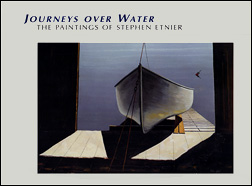 |
||||||||||
|
|
||||||||||
 |
||||||||||
|
Journeys over Water
Essay for the 1998 exhibition catalog by Daniel. E. O'Leary, curator courtesy of Portland Museum of Art reproduced by permission. Presented in four parts: Introduction | I | II | III |
||||||||||
|
Introduction
Few American artists have led more adventurous lives than Stephen Morgan Etnier [1903-1984]. Few human beings have been more independent. The biographies of many artists document personal journeys, but they rarely convey the remarkable sense of pilgrimage and quest present throughout the career of Stephen Etnier. Etnier fused his vocation as a painter with his restless disposition, pursuing a lifelong affair with large sailboats and yachts, elegant automobiles, and private airplanes. He explored the Atlantic and Pacific coasts for over sixty years and dropped anchor off many islands in the Caribbean. Etnier's life and his art were intensely interrelated. He chose to paint chiefly on-site, and brought a sense of discovery to every setting he encountered. In a century when art has become introspective and abstract, Etnier's paintings offer rare examples of straightforward autobiography and provide meticulous documentation of his journeys and tastes. He measured out his life in a unusual record of adventure and exploration. Throughout a career that spanned six decades, Etnier was highly prolific and extremely self-critical. He altered and destroyed many paintings. He habitually rose before dawn to capitalize on the qualities of early morning lights and pushed himself to paint in a journeyman fashion that trusted in discipline and diligence. His paintings were crafted for individuals who responded to his values. Although he began his career with excellent ties to New York galleries, he gradually divorced himself from the influence of the established art world. (1) It is therefore not surprising that his career brought him enthusiastic and widespread patronage from collectors but relatively little support from institutions. (2) His chief preoccupation was with depicting the nature and vitality of lights. He can be understood as a twentieth-century descendent of the American Luminists, and in particular of the nineteenth-century Boston painter Fitz Hugh Lane, whom he greatly admired. Etnier set of himself the task of recording the visual impact of the sun and its role in creating atmosphere and texture. Light, rather than the world it illuminated, was his essential subject. For Etnier the phenomenon of light was most intriguing when it generated attenuated diagonals of brightness and shadow or when it advanced towards the foreground of his paintings. His work demonstrates a long obsession with rendering light as it approaches the viewer. Many of his figures studies, and even his portraits and self-portraits, are backlit. In Etnier's paintings, landscape and figures exist and function within the definitive reality of light. Because of his enthusiasm for adventure and Caribbean wanderings, Stephen Etnier (1903-1984) can easily be compared with his close contemporary, Ernest Hemingway (1899-1961). Like Hemingway, Etnier sought out adventures that supplied the subject matter of his art. Each man strove to define himself as an independent and heroic figure. (3) Etnier was an aficionado of ocean sailing, stylish automobiles, airplanes, and island life. (4) He was clearly intrigued with whimsical displays of American commercialism. His lifelong enthusiasm for technology and consumer culture provided a series of themes that were explored by few other artists of his generation. Many of his paintings focus on signage, storefronts, advertising gimmicks on America's unrefined commercial face, with its contrived energy and tawdry kitsch. Etnier was a scion of America's Ash Can School, cut loose from city life, navigating among scenic coastal splendors and waterfront dives, from Maine to Florida, New Orleans, Jamaica, Nassau, Haiti, Barbados, and the Bahamas. He became a Jack Kerouac of the inland waterway, with deeper pockets and better social connections. But if Stephen Etnier is to be likened to a single American writer, it would most appropriately be John Steinbeck the Steinbeck of Cannery Row, Sweet Thursday, and Travels with Charley. Like Steinbeck, Etnier was devoted to the pursuit of rudimentary American realities. Etnier's career produced an artistic travelogue, an inventory that is endlessly alert to the unsophisticated flavor of American life. He was a vagabond cultural observer, for whom the visual slang of American revealed his country's truest character. Stephen Etnier lavished particular attention and sensitivity upon Maine, his chosen home and source of identity. A native of York, Pennsylvania, Etnier came to Maine first as a summer resident, then as a devoted sailor, a summer pioneer on Gilbert Head, and for the last thirty-five years of his life, as an established citizen at South Harpswell. In his evolution as a painter, Stephen Etnier passed through three artistic phases. Each phase or period was characterized by a separate and distinctive style. The unifying feature of the three phases was Etnier's remarkable devotion to light.
|
||||||||||